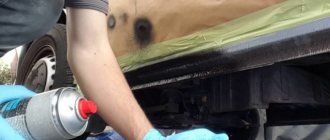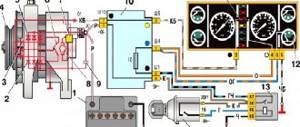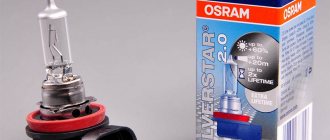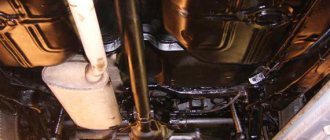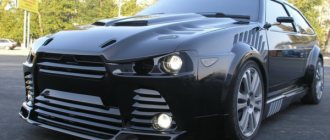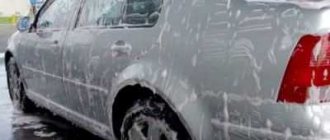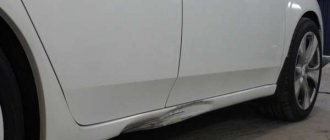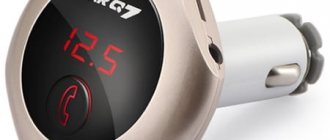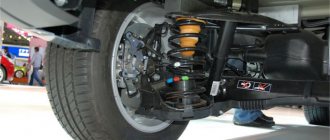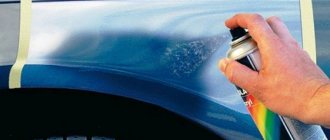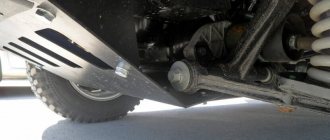Corrosion on a car body is a real problem for many car owners. For example, if you need to save your car and, accordingly, protect the metal of the body from atmospheric corrosion processes. Today there are several options for such protection - this is a passive method, active, and also transformative.
In the case of the active method, special protective compounds are used that create stable compounds on the metal surface that protect the body from corrosion processes. One of the most famous and popular drugs of this kind is the drug “Movil”. What it is? This is a mixture of motor oils, drying oils, and inhibitory additives. The composition also contains solvents - white spirit or kerosene. This preparation forms a dense combined film on the metal surface that does not allow oxygen and water to pass through. And these are the main factors that cause iron to rust.
Operating principle
The anti-corrosion or preservative agent "Movil" has a principle of operation based on the most complete sealing and insulation of metals. This makes it possible to be in close contact with air and moisture, which are the main cause of corrosion on bodies. In addition, thanks to the inhibitor, this composition immediately after application begins to actively fight pockets of corrosion.
For car enthusiasts this is a big plus. Treatment with Movil can be carried out without the need to remove bitumen mastic. When the composition is applied to such insulating materials, it tightly covers the surface and passes through the protective layer directly to the metal through various cracks - this is guaranteed insulation of the metal from corrosion. If corrosion processes have already started, then with the help of Movil you can stop the growth of rust.
If you need to park your car for a long time, experts recommend treating the body with this composition as much as possible in all places, so that then, after the expiration of the storage period, you can take the car from the parking lot in its original form.
It is not recommended and even prohibited to use the drug if there is a risk of it getting on rubber parts. Due to the substances included in the composition, rubber will quickly become completely unusable.
What is Movil
A problem such as metal destruction is easier to prevent than to fix later. A product called Movil is one of the popular ones. Many people use it, but it turns out that many do not know how to apply it correctly. The quality of the work performed depends on the technology for applying the anti-corrosion composition.
Movil is any anti-corrosion substance. It must contain the following mandatory substances:
- engine oil;
- drying oil;
- components that protect against corrosion.
If the anti-rust product contains other substances, has a different composition, then this product is no longer Movil. The original Movil product was developed several decades ago.
Where did the name Movil come from? Answer: because this substance was invented by chemists from Moscow and Vilnius.
Due to its low price and high quality, Movil has been used for more than 50 years to prevent and eliminate corrosion of metal car bodies.
In one issue I published material about Gravitex for cars. Look, this remedy is also effective. The question of how to choose this substance and how to use it was discussed.
There is also a technology to isolate the metal surface from oxygen in the air. This can be done either with paints or film. For example, there is a film against chipping.
Advantages of Movil
The product can be applied both to unpainted metal surfaces and to any coatings treated with varnishes and paints. After metal processing there is no need for drying. As a result of application, a reliable protective layer is created that not only prevents moisture from reaching the metal, but also repels it. Other advantages include the absence of a negative effect on metal and any paints. All this makes the product quite effective in combating corrosion. Many car enthusiasts successfully use Movil. What it is? This is a powerful weapon for fighting rust.
This drug is simply irreplaceable when you need to defeat pockets of corrosion in hard-to-reach areas of the machine. It differs from other products in its high fluidity - the substance easily penetrates even into minor cracks and cracks.
Composition and principle of action of Movil
The operating principle of Moville is that this substance penetrates the microscopic pores of iron oxide, and the rust converter transforms the oxides into a special form of iron. In this case, polymer resins leave a protective film on the surface, which prevents subsequent oxidation.
The anti-corrosion agent contains the following ingredients:
- White Spirit;
- machine oil;
- drying oil;
- inhibitors;
- corrosion converter;
- kerosene.
For what surfaces is Movil anticorrosive agent intended?
This anti-corrosion agent is intended for treating metal, including those coated with a layer of paints and varnishes. It is forbidden to treat rubberized elements and surfaces on which synthetic preparations are applied with Movil.
How to prepare a car for processing?
First you need to prepare the surface and then apply Movil directly. What it is? This is a simple preparation that will make the drug even more effective.
First of all, the car must be thoroughly washed. If you plan to treat the bottom, then it is washed while the car is on the lift. It is best to use a pressure washer with hot water. After the procedure, the body must be thoroughly dried.
How to use Movil
To get the most out of this preservative, you need to know how to apply it correctly. Metal processing is carried out using a special tool - this is a gun through which the drug is sprayed.
Thanks to spraying under pressure, Movil penetrates into any cracks and cavities that are already corroded or those that need to be protected. Open areas can be treated with a regular brush.
After treating the area, the surface is degreased. It is best to spray the drug at temperatures from 10 to 30 degrees. A more effective option is to apply several, preferably 2-3 layers.
To process a square meter of metal in one layer you will need about 400 g of Movil. Drying time is about 2 hours. The product can be supplied as a mass in a plastic container. There is also Movil-aerosol, but the disadvantage of such packaging is its small volume.
If the product accidentally gets on the paintwork, it will be very difficult to clean it. If there are drops on the paint, they are removed immediately (until they harden). If there are any plugs on the body, it is better to remove them so that the anti-corrosion substance can easily get into any places.
"Movil 2M"
This is a domestic product. The company is located in Moscow. The drug is supplied in a can. After processing, a thin transparent and fairly uniform film is created on the surface. This product withstands the Russian winter well. If a drop of this composition gets on the paint, it can be easily removed with gasoline. The product impregnates rust and has medium fluidity.
Features of the autopreservative Movil
Operating principle and composition of the mixture
Since its inception, the formula of the autopreservative has not changed much - it is still a film-forming inhibited petroleum composition (PINS). The type of converter used in the mixture varies by manufacturer. The functional side of the composition is as follows:
- Penetration of hydrated iron oxide into micropores due to the presence of penetrate inhibitors in the composition.
- Transformation of oxides into a non-corrosive configuration of iron.
- Formation of a protective surface film based on polymer resins.
What does it consist of?
The last factor excludes the access of oxygen and moisture, due to which further oxidation of the part is impossible. You can understand what Movil for cars is and how to use this product after studying its composition. The overall characteristics of the mixture are formed by its main “ingredients”:
- Drying oil.
- White Spirit.
- Inhibitors.
- Kerosene.
- Engine oil.
- Rust converter.
You can find out which converter is present in the mixture from the information on the can. For example, the Agat-Avto concern has used tannin, which reformats oxides into iron tannate.
Who produces?
On the shelves of domestic auto stores you most often find Movil with a converter from the following manufacturers:
- Astrochem - Antiruster aerosol with a rust converter.
- Agat-Auto - Movil corsenvant with converter.
- Development of PKF - liquid and aerosol HH MasterWax with converter.
- Eltrans is an aerosol with a converter.
The product packaged in cans is half the price of aerosol packaging. If you plan to treat the body with liquid Movil using a brush, then there is an opportunity to save money. On the other hand, there are places where you can’t reach with a simple brush, and then you can’t do without an aerosol.
You can still find car owners who do not recognize anything other than Cannon Tallow, a preservative petroleum lubricant. They justify their choice by reliability and low cost. However, beginners are faced with the problem of preparing the mixture, since it is difficult to process the internal cavities of a car with a thick consistency, so there is no reason for them to choose “pussalo”.
What is "Movil"?
Many motorists call any anti-corrosion agent for a car Movil, but this is incorrect. The original Movil contains the following components:
- Engine oil.
- Drying oil.
- Anti-corrosion substances.
If an anti-corrosion drug has a different composition, then it cannot be called Movil. A product for protecting the body from rust, under the original name “Movil,” was simultaneously developed by research institutes located in Moscow and Vilnius, for which it received its name from the first letters of these cities.
Anticorrosive agent was invented in the last century, but despite the huge range of various anti-corrosion agents available on the Russian market, this anti-corrosion agent is still in high demand among car owners today, due to its low cost and high quality.
To know which Movil to choose for your car and how to use this anti-corrosion agent, you need to determine what type of rust preventative to purchase for treating the body.
Types of anticorrosive
Types of Movil for cars are presented in 3 categories:
1. Aerosols are the most popular and convenient means for applying anti-corrosion composition.
The price of a 520 ml can ranges from 200 to 300 rubles. Treating the car body with such packaging will cost the motorist much more, due to the gas inside the canister, which is used for spraying.
The inconvenience of using this type of anticorrosion agent may also lie in the need to keep the canister in a vertical position, so for anti-corrosion treatment it is better to purchase a canister equipped with a special tube with a spray at the end.
2. Liquid Movil is an inexpensive option for use as an anti-corrosion treatment. The cost of a 3-liter canister is only 300 - 400 rubles.
The consistency of the liquid composition allows for effective treatment of hidden cavities. The product is easily applied to thresholds and internal door cavities. You can get the most even distribution of the substance inside hidden cavities using an original spherical nozzle, which allows you to process every square centimeter of the internal area of the metal elements of the body.
3. Paste-like Movil, most often sold in tin or plastic packaging, in the form of cans.
The cost of such a drug for treating a car is about 200 rubles. per package weighing 0.86 kg. The product is applied to the surface to be treated with a brush, and to treat internal cavities it is diluted with a solvent.
After a vehicle body treatment product has been selected, it is necessary to thoroughly prepare the body surface on which the anti-corrosion compound will be applied.
Preparing the car
The underbody of the car is most often subjected to anti-corrosion treatment. This part of the body is most susceptible to destructive processes, especially when the car has to be operated in high humidity.
Mechanical damage from stones and sand from under the wheels also causes significant damage to the lower part of the car body. The following body elements are subjected to anti-corrosion treatment using Movil:
- Spars.
- Floor thresholds.
- Door pockets.
- Front and rear arches.
- Central pillars.
- Headlight covers.
All listed places must be properly prepared. First of all, it is necessary to thoroughly clean the surface to be treated from dirt and dust. For this purpose, you can use a portable car wash with the addition of special detergents that will clean the surface not only of dirt, but also of oily deposits.
After thorough cleaning. The surface on which Movil will be applied must be free from moisture. If the treatment is carried out in the summer, then it is enough to dry the car in the open air for several hours. In cold or damp seasons, you need to use a compressor to remove moisture. Blowing with compressed air will reliably remove moisture from the surface, after which it will be possible to apply the working solution to the metal surface without any obstacles.
After cleaning the surface of the underbody of the car from contamination, you should inspect the paintwork of the lower part of the body. If areas of paint peeling or swelling of the paint are identified, then such areas must be cleaned with a wire brush or coarse sandpaper. If pockets of rust are found on the underside of the car, such places must also be properly treated before applying Movil.
You can also use sandpaper or a grinder to remove corrosion.
When the metal surface is cleaned, it should be treated with any rust converter in order to stop the destructive process in the metal.
Which body cavities need Movil treatment and why?
There is a misconception that the underbody of a vehicle can be treated with a preservative. This approach is irrational, since only anti-gravel coating can withstand mechanical stress. Anticorrosive agent works effectively in limited places where there is a high probability of corrosion pockets:
- Thresholds. The holes in them allow moisture to penetrate and, as a result, rust to form.
- Front roof pillars. Condensation that occurs due to temperature differences leads to corrosion processes over time.
- Spars and space between the wheel arch and rear wing.
- Inner plane of the trunk. Often the compartment is lined with felt material, which absorbs and retains moisture well.
- Floors and interior doors. Moisture and condensation quite often accumulate in these places.
- Door seal mounting locations. Water accumulates under the rubber and provokes the formation of rye and mold.
Technology: how to use Movil solution to protect cars and precautions
To complete the work, it is important to select the consistency of the mixture by adding a solvent. It must be remembered that the fluidity of the solution depends on the ambient temperature; 20°C is considered optimal. The treatment procedure using an aerosol looks much simpler, because the mixture is already in working condition.
Treatment of easily accessible areas
For those who are interested in how to use Movil anticorrosive for cars in easily accessible places, you should familiarize yourself with the following points:
- Prepare the surface by removing dirt and loose layers of oxides.
- Degrease the work area and dry it.
- Apply the first layer of anticorrosive with a roller or brush. If an aerosol is used, the can should be shaken several times beforehand. The solution is fed through the spray head.
- Dry and apply a second and, if necessary, a third layer with intermediate drying.
- The coating dries completely within 24 hours; it is not advisable to operate the car during this period.
Important! If preservative gets on the surface of the paintwork, it must be quickly wiped off with a cleaner for bitumen stains.
Treatment of hidden cavities
The operation has its own characteristics and proceeds according to the following scheme:
- Remove elements that interfere with the work process.
- If there are drainage holes, rinse the cavities thoroughly.
- Treat the cavity with a rust converter and rinse after a while using an alkaline reagent.
- Dry the closed cavity with a stream of warm air.
- Connect the flexible tube from the kit to the cylinder; if the cylinder is designed to work with a gun, then install it in its regular place.
- Insert the end of the tube or gun into the technological hole and spray the anticorrosive agent.
For processing car body treatment with Movil, sprayers with a working pressure of 3-11 MPa (for airless spraying) or 2-4 atmospheres for air application are suitable.
How to apply Movil correctly. Instructions for use
Providing anti-corrosion protection with Movil is carried out according to the following scheme:
- First, the surface is cleaned and disinfected.
- Then the parts to be processed are thoroughly dried.
- After this, 1 layer of the drug is applied. To do this, you can use a spray tube or a brush.
- After applying 1 layer, the surface is left to dry. To speed up this process, the treated area can be blown with warm air.
- Then the 2nd and 3rd layers of the product are applied.
- This is followed by final drying.
How to treat hidden cavities
To create protection for hard-to-reach areas from corrosion with Movil, the following features must be taken into account:
- It is necessary to dismantle parts that make it difficult to access the treated areas.
- The cavities can be washed with clean water through the drainage slots.
- Then they need to be treated with an anti-corrosion agent and washed with an alkaline solution, which is selected depending on the type of converter.
- After this, the cavities need to be dried with warm air.
- Layers of anti-corrosion composition must be applied with intermediate drying.
Safety measures when performing work
An indispensable condition is effective ventilation and fire safety; the measures are the same as when painting wheel rims. If any preservative gets on the skin and, especially, in the eyes, you should immediately rinse them with clean water and consult a doctor. They say that the mixture is safe for rubber products in the form of seals and for paintwork, but this is an absolute misconception - practice has proven that dried stains are practically impossible to remove.
To prevent unpleasant stains on the floor in the garage, the car should be placed in the sun after 24 hours or in a room with a temperature of at least 25°C. Under the influence of high temperature, excess solution will drain through the service openings, after which they must be closed.
As a result, we can confidently state that the car preservative is still capable of increasing the level of anti-corrosion protection of the car. Subject to Movil technology and safety rules, such processing is reliable and very affordable financially.
Movil, what is it? This question interests many who have encountered corrosion on the car body, and why Movil is needed immediately becomes clear - in order to protect the body from corrosion. Despite the fact that modern cars are well protected from corrosion, this does not mean that rust will not form, since winter driving around the city has a very unfriendly effect on the body’s resistance to corrosion. Movil for cars: we will now find out how to use it.
Therefore, it is advisable to additionally treat the car body with Movil, the method of application of which is not as complicated as it may seem at first. What is Movil for cars? This is simply an indispensable tool for those who love their car and drive it all year round.
Of course, in addition to Movil, there are many other products on the market that are created to improve the anti-corrosion properties of a car. But Movil has proven itself very well, because it is inexpensive, which is why it is so popular in Russia, and its quality is at the level of its foreign analogues. Movil is a substance that prevents metal from coming into contact with the external environment, namely moisture and air. If the metal is not exposed to moisture, then rust will not form.
Movil was developed at institutes in Moscow and Vilnius, which is why it has such a name. Movil contains drying oil, machine oil and corrosion inhibitors. During application to the body surface, you can even add kerosene or white spirit to Movil to make it easier to apply. Thanks to white spirit, Movil will retain its plasticity longer and will not crack, and kerosene will erode faster.
Briefly: why do we need Movil?
The primary task for which Movil is created and used to this day is to protect the body and other metal parts from corrosion.
Today, it is customary to call almost any anti-corrosion agent Movil. But do not forget that in the beginning only those anticorrosion agents that contained motor oil, drying oils and corrosion inhibitors were called this way. The unique recipe has been used since Soviet times; it was developed by specialists from research institutes in Moscow and Vilnius, hence the original name.
This product makes it easy to treat hidden cavities
Modern anticorrosion agents have almost completely preserved the original composition and are now created on the basis of:
- motor oil;
- drying oils or other film-forming substances;
- anti-corrosion substances;
- solvents.
Each component has its own individual function. For example, thanks to motor oil, a protective layer is created on the metal surface of the body, isolating it from the effects of oxygen. In addition, the oil prevents the body and important elements from coming into contact with water, steam and other substances hazardous to metal.
Movil in cylinders is convenient due to application
The task of anti-corrosion additives is to stop pockets of rust and stop their development, simultaneously preventing the emergence of new pockets. Thanks to these components, when applying the composition, a special film is formed that protects the applied layer from rapid evaporation, mechanical damage and contamination.
The solvent is added to ensure that the consistency is moderately viscous. It is on this that the change in the individual properties of the composition depends. For example, anticorrosive with the addition of kerosene has the weakest odor, which quickly disappears. But Movil with white spirit retains its plasticity longer, resists cracks better, dries more slowly, but has a more persistent odor.
How strong the smell of the product will be depends on the solvent added by the manufacturer.
Movil for cars: how to use it correctly
Movil for cars: how to use it is quite simple to understand - you just need to apply it to arches, hidden cavities, welds, anywhere where moisture can linger. But before applying, you need to carefully treat those places where rust has already appeared. Because even if you apply Movil to a rusty part, the rust will still continue to develop, but more slowly.
But Movil has a rather specific smell, so it’s better not to treat anything with it in the salon. What color is Movil - when it dries it turns dark brown. When using Movil, it is important to thoroughly dry the surface so that there is no moisture there at all, otherwise the moisture will simply remain under the protective layer, and perhaps corrosion will begin to appear under the protective layer, which will not lead to anything good.
When the surface is prepared, you can apply Movil either by spraying or coating, depending on the case, you need to select the correct consistency of Movil using a solvent. If the mixture turns out to be very thick, it may not penetrate into some seams, and it will also lie unevenly. If the mixture turns out to be very liquid, it may not stay on the surface. Also, the consistency depends on the temperature, so it is best to apply Movil in a warm room. If you do work in the heat, the material will become more liquid and the smell will be very pungent, so in the heat you need to add less solvent.
Movil aerosol is available for sale; it has the correct consistency already selected and does not require application devices. In the case of an aerosol, anti-corrosion protection must be done in several layers, because the thickness of one layer is quite small. The durability of this layer is also less, since the spray here is quick-drying.
If hidden cavities are found, they must be treated by extrusion without spraying; for this you can use a special metal tube. The main thing is to achieve an even distribution of Movil.
Let dry
In addition, after Movil has been applied to the body, you must wait at least one day for Movil to thicken. Moreover, there is no need to dry anything additional. It is not necessary to wait until the substance has completely dried, because Movil for cars should not dry out, it simply thickens, becomes elastic, but not dry.
Which parts of the car are recommended to be treated with Movil:
- door pockets,
- arch cavities;
- spars;
- hood and trunk;
- headlight housings;
- floor thresholds;
- body pillars.
But open surfaces that are exposed to the external environment, such as the bottom of a car, do not need to be treated with Movil, since it is better to use an anti-gravel coating for this and provide full anti-corrosion protection.
It is believed that Movil contains a rust converter, so the surface does not need to be pre-treated. But there is not much of this converter there, so it is better to treat the body before using Movil - completely remove the rust, and then apply Movil.
Safety during use
When working with Movil, you need to ensure that there is good ventilation, and remember that Movil contains components that are easily flammable. Also, do not allow Movil to come into contact with the skin or other parts of the body.
It is necessary to ensure that Movil does not come into contact with rubber or plastic parts, because it will have a negative effect on them. You also need to remember that a stain of frozen Movil is difficult to remove later, so you need to apply the substance carefully.
It also happens that excess substances can drain from the car onto the garage floor. Therefore, you can first lay down oilcloth to keep the floor clean.
It is also advisable to check the condition of the car’s anti-corrosion coating every few months. If it is noticed that the Movil has hardened and is no longer elastic, this means that the treatment must be repeated, and the composition must be made more liquid. But the old layer must be removed using a solvent or using a product that removes bitumen stains.
If you follow all the rules and recommendations for using Movil, you can achieve excellent protection of the car body from corrosion for a fairly reasonable price.
And then a video about how you can move a car with your own hands:
Treatment with Movil, types of chemicals, application methods
Removing rust from a car body with your own hands
Such a protective agent against corrosion as Movil appeared in the Soviet Union; the drug was developed by scientists in Moscow and Vilnius, and therefore its name consists of abbreviated words from these two cities. First of all, the chemical composition was intended for the preservation of cars; its dense elastic layer is able to reliably protect body iron from the penetration of air and moisture.
The standard components included in the anti-corrosion coating are drying oil, machine oil, inhibitor additives, solvents are also present, currently there are various modifications of this drug:
- Movil with zinc;
- classic composition;
- with rust converter;
- with natural wax.
Anticorrosives also differ in the method of application; the standard version of Movil is a thick, viscous liquid; preparations are also produced in the form of a spray, they are sold in aerosol cans. Anticorrosion treatment can be done using a brush or roller, but it is more convenient to apply a layer by spraying the product under pressure. If Movil is packaged in a regular container such as a can, spraying is done using a spray gun, and compressed air is supplied by a compressor.
The modern drug Movil differs significantly from the preservative produced in the USSR; an anti-corrosion agent for protecting the body is now being developed and produced by various companies, produced not only in Russia, but also in Belarus and Lithuania. The most well-known manufacturers of the drug today:
- joint stock company "Nikor" (St. Petersburg);
- PKF (Nizhny Novgorod);
- "Stesmol" (Belarus);
- "Agat-Auto";
- "Astrokhim";
- Limited Liability Company "Eltrans";
- JSC "Elf Filling" (the last four companies mentioned above are Moscow manufacturers).
Among car enthusiasts, the “Movil-NN” brands produced in Nizhny Novgorod and “Movil-2M” from Nizhny Novgorod are quite popular; the preservative composition under the Kerry brand (“Elf Filling”) is also quite well known. The price of the preservative depends on the brand, packaging volume, and the seller himself; the average cost of Movil in a can or jar with a volume of 400-1000 ml is from 130 to 500 rubles.
